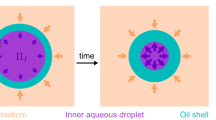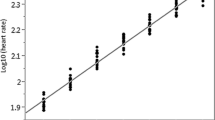Abstract
Living cells, tissues and organisms are open, metabolically active systems that constantly exchange matter and energy with their environment in the form of heat. The heat exchanged is equal to the net enthalpy of all chemical reactions taking place within the system. Thus, heat dissipation can inform on the energetic costs of the constellation of cellular processes that contribute to physiology and address unanswered questions about development, responses to the environment, signaling and metabolic pathways, and the roles of morphological substructures. Here, we describe the methods we established to measure the heat dissipated by early zebrafish embryos undergoing synchronous cell cycles of cleavage stage embryogenesis, using isothermal calorimetry. The non-invasive nature of calorimetry and the versatility of these methods enables the investigation of the energetic costs of embryonic development and of the cellular processes associated with the early embryonic cell cycles.
Access this chapter
Tax calculation will be finalised at checkout
Purchases are for personal use only
Similar content being viewed by others
References
Kane DA, Kimmel CB (1993) The zebrafish midblastula transition. Development 119:447–456
Newport J, Kirschner M (1982) A major developmental transition in early Xenopus embryos: I. Characterization and timing of cellular changes at the midblastula stage. Cell 30:675–686
Ikegami R, Rivera-Bennetts AK, Brooker DL et al (1997) Effect of inhibitors of DNA replication on early zebrafish embryos: evidence for coordinate activation of multiple intrinsic cell-cycle checkpoints at the mid-blastula transition. Zygote 5:153–175
Kimelman D, Kirschner M, Scherson T (1987) The events of the midblastula transition in Xenopus are regulated by changes in the cell cycle. Cell 48:399–407
Newport JW, Kirschner MW (1984) Regulation of the cell cycle during early Xenopus development. Cell 37:731–742
Paranjpe SS, Veenstra GJC (2015) Establishing pluripotency in early development. Biochim Biophys Acta 1849:626–636
Loog M, Morgan DO (2005) Cyclin specificity in the phosphorylation of cyclin-dependent kinase substrates. Nature 434:104–108
Novak B, Tyson JJ (1993) Numerical analysis of a comprehensive model of M-phase control in Xenopus oocyte extracts and intact embryos. J Cell Sci 106(Pt 4):1153–1168
Murray AW, Hunt T (1993) The cell cycle: an introduction. Oxford University Press, Oxford
Tsai TY-C, Theriot JA, Ferrell JE Jr (2014) Changes in oscillatory dynamics in the cell cycle of early Xenopus laevis embryos. PLoS Biol 12:e1001788
Kamenz J, Ferrell JE Jr (2017) The temporal ordering of cell-cycle phosphorylation. Mol Cell 65:371–373
Miyazawa H, Aulehla A (2018) Revisiting the role of metabolism during development. Development 145:dev131110–dev131111
Ward PS, Thompson CB (2012) Metabolic reprogramming: a cancer hallmark even warburg did not anticipate. Cancer Cell 21:297–308
Agathocleous M, Harris WA (2013) Metabolism in physiological cell proliferation and differentiation. Trends Cell Biol 23:484–492
Gardner DK, Leese HJ (1990) Concentrations of nutrients in mouse oviduct fluid and their effects on embryo development and metabolism in vitro. J Reprod Fertil 88:361–368
Gardner DK (1998) Changes in requirements and utilization of nutrients during mammalian preimplantation embryo development and their significance in embryo culture. Theriogenology 49:83–102
Houghton FD, Thompson JG, Kennedy CJ et al (1996) Oxygen consumption and energy metabolism of the early mouse embryo. Mol Reprod Dev 44:476–485
Jusup M, Sousa T, Domingos T et al (2017) Physics of metabolic organization. Phys Life Rev 20:1–39
Rodenfels J, Neugebauer KM, Howard J (2019) Heat oscillations driven by the embryonic cell cycle reveal the energetic costs of signaling. Dev Cell 48:646–658.e6
Rodenfels J, Sartori P, Golfier S et al (2020) Contribution of increasing plasma membrane to the energetic cost of early zebrafish embryogenesis. Mol Biol Cell 31:520–526
Song Y, Park JO, Tanner L et al (2019) Energy budget of Drosophila embryogenesis. Curr Biol 29:R566–R567
Nagano Y, Ode KL (2014) Temperature-independent energy expenditure in early development of the African clawed frog Xenopus laevis. Phys Biol 11:046008
Acknowledgements
We thank Dr. Jonathon Howard and the participants of the 2015 Physiology course at the Marine Biology Laboratory in Woods Hole, MA for helpful discussion during the inception of this project. This work was supported by funding from an EMBO Long-term Fellowship ALTF 754-2015 (to J.R.) and the NIH R21 HD094013 (to K.M.N.). Its contents are solely the responsibility of the authors and do not necessarily represent the official views of the NIH.
Author information
Authors and Affiliations
Corresponding author
Editor information
Editors and Affiliations
Rights and permissions
Copyright information
© 2021 Springer Science+Business Media, LLC, part of Springer Nature
About this protocol
Cite this protocol
Rodenfels, J., Neugebauer, K.M. (2021). Calorimetric Heat Dissipation Measurements of Developing Zebrafish Embryos. In: Coutts, A.S., Weston, L. (eds) Cell Cycle Oscillators . Methods in Molecular Biology, vol 2329. Humana, New York, NY. https://doi.org/10.1007/978-1-0716-1538-6_22
Download citation
DOI: https://doi.org/10.1007/978-1-0716-1538-6_22
Published:
Publisher Name: Humana, New York, NY
Print ISBN: 978-1-0716-1537-9
Online ISBN: 978-1-0716-1538-6
eBook Packages: Springer Protocols




